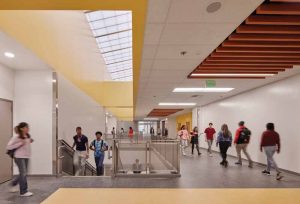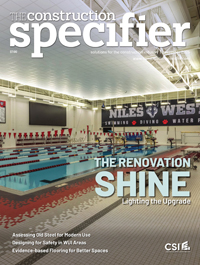Grover Cleveland High School: A modern solution for a mid-century facility

The inclusion of quality spaces outside the traditional classroom setting, where positive social interactions and activities can occur, significantly contributes to students’ sense of belonging. Research has shown a strong sense of belonging is associated with higher student achievement, making these thoughtfully designed environments crucial for academic success and overall well-being.1
Connecting to nature with translucent wall systems and skylights
Embracing the principles of biophilic design, the architects skillfully blended natural elements into every corner of the campus. The science atrium, for instance, features a translucent skylight that allows dynamic and diffused daylight to permeate the space, enhancing the connection with the outdoors. Vision glazing and skylights were also strategically placed in corridors, lobbies, and classrooms to maximize natural daylighting and provide glimpses of nature. By utilizing the translucent wall and skylight systems, the campus is illuminated with soft, diffused natural daylight, avoiding harsh glare or heat caused by direct sunlight.
The benefits of daylighting
Daylighting is a crucial aspect of building design that has gained increasing importance. Recent years have seen a widespread recognition of the significant impact daylight can have on the morale and productivity of individuals residing or working indoors. Unlike electric light, daylight fosters a sense of connection to the outdoors and renders the full array of colors in a meaningful way that cannot be easily replicated.
In the realm of education, numerous studies have highlighted the advantages of daylighting, particularly in schools.2 The research indicates that students perform better and achieve higher academic results in schools that incorporate daylight, as opposed to those relying solely on electric lighting. As a result, daylighting has become a fundamental consideration in educational space design. It contributes to the creation of a pleasant environment, enhances academic performance, promotes better health, and enables substantial energy savings.
For example, a study conducted by Lisa Heschong3 found that students in naturally lit classrooms progressed 20 percent faster in math tests, 26 percent faster in reading tests, and when end-of-year test scores were used as the outcome variable, students in classrooms with the most daylighting were found to have 7 to 18 percent higher scores than those with less daylight Further, buildings can decrease their energy consumption by reducing the need for electric lighting throughout the day. Daylight is also more efficient than electrical light, producing less heat and more light output. Consequently, incorporating daylighting into building design has been proven to reduce cooling requirements by up to 15 percent, and decrease electric lighting consumption by 75 to 80 percent.
In short, ample and well-integrated daylighting plays a fundamental role in biophilic design, as it bridges the gap between indoor and outdoor environments, creating a sense of connection with nature. By prioritizing daylighting in building design, building professionals can create spaces that optimize the human experience and align with sustainable and biophilic principles.








